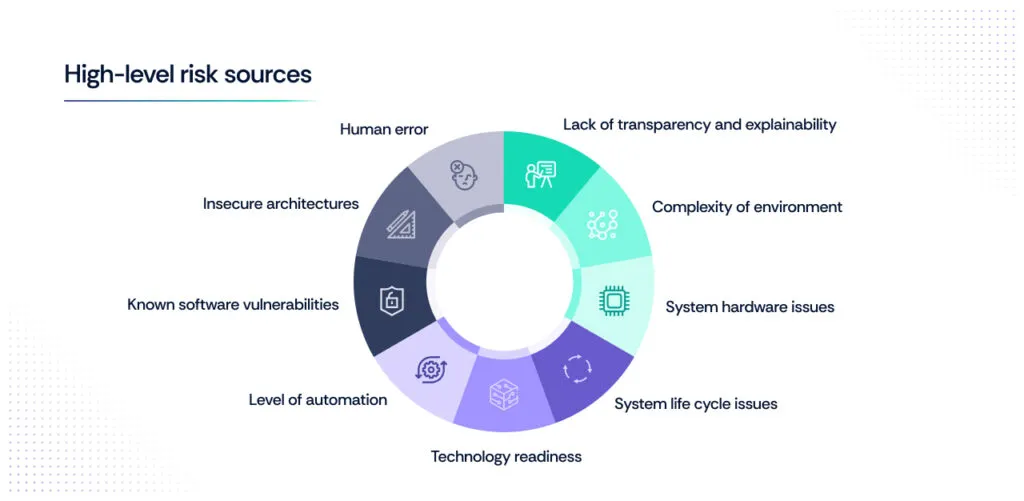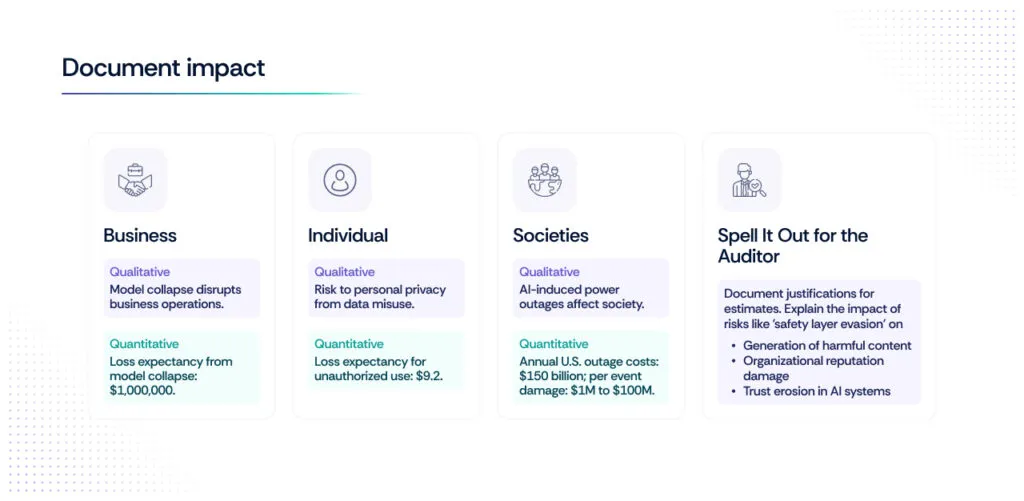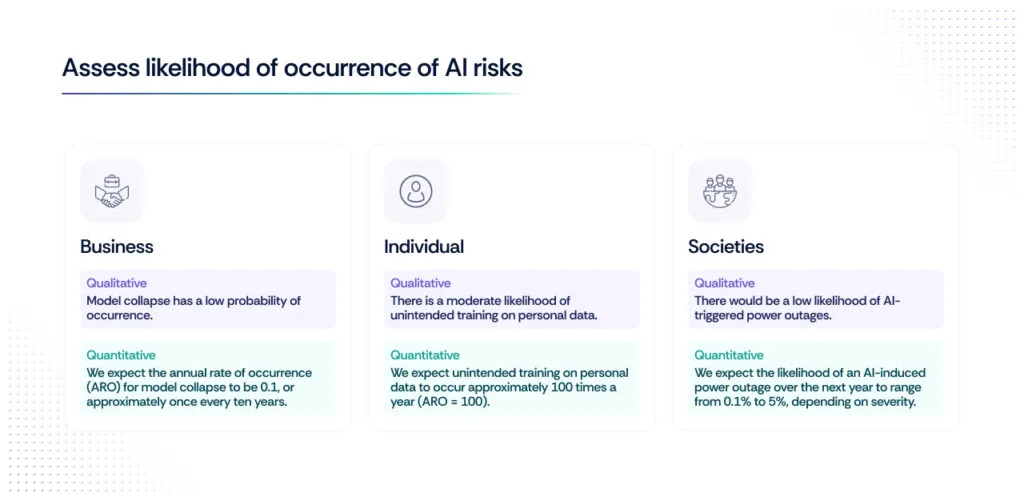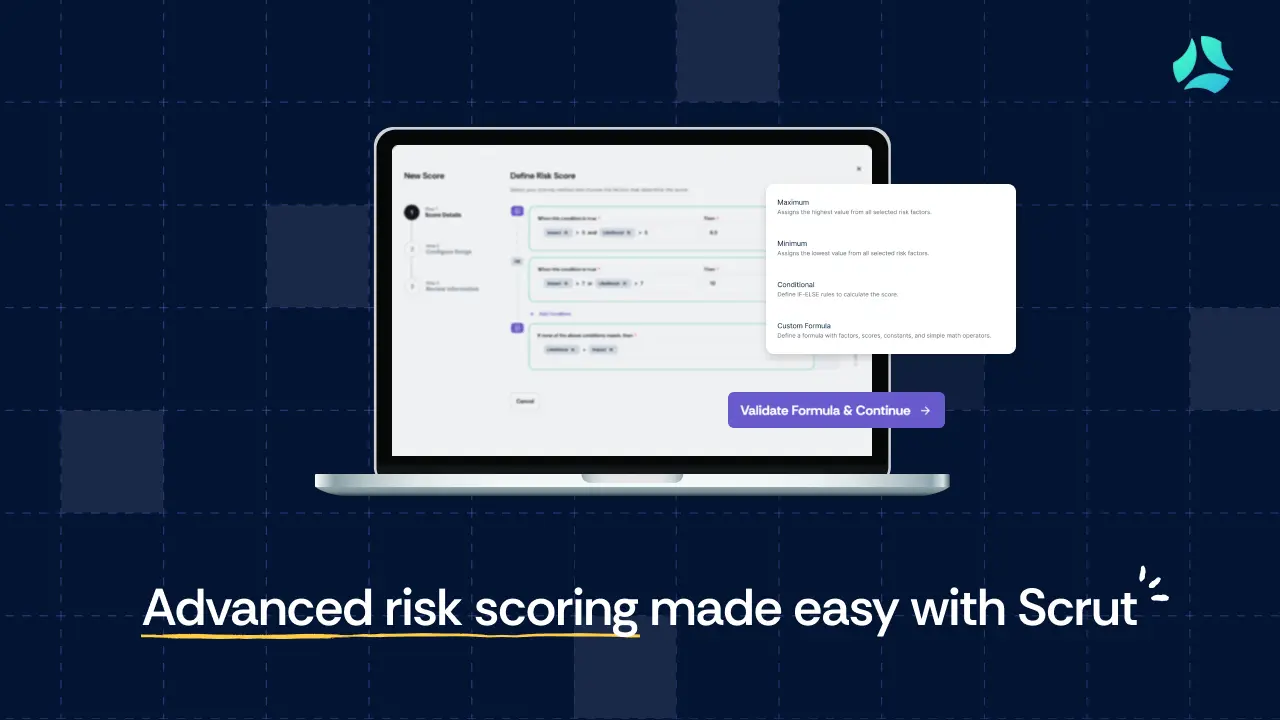How to carry out ISO 42001 AI risk assessments

ISO/IEC 42001:2023 is the new kid on the block regarding compliance standards. Released at the end of 2023, it establishes guidelines for building an Artificial Intelligence Management System (AIMS). We reviewed the standard at a high level in a separate post, but we will delve into AI risk assessments in this one.
Clause 6.1.2 of the standard requires organizations to “define and establish an AI risk assessment process.” It offers a few additional requirements for how to do so, such as requiring these assessments to consider “potential consequences to the organization, individuals, and societies.” However, it doesn’t offer detailed guidance.
A separate publication, ISO/IEC 23894:2023, specifically focuses on AI risk assessments, but even that leaves something to be desired regarding real-world applications. So in this blog, we’ll offer some practical recommendations on how to go about AI risk assessments before the ISO 42001 certification process.
Think broadly, but don’t boil the ocean

ISO 23894 provides a useful set of high-level risk sources that can help spur your risk management brainstorming process, including:
- Lack of transparency and explainability.
- Complexity of environment.
- System hardware issues.
- System life cycle issues.
- Technology readiness.
- Level of automation.
With that said, these aren’t necessarily comprehensive. While ISO/IEC 27001:2022 focuses on information security and privacy, there is some overlap with ISO 42001. Thus, it would also make sense to consider familiar sources such as:
- Known software vulnerabilities.
- Insecure architectures.
- Human error.
In addition to the sources of risk, you’ll need to identify assets and their value. These include various levels such as:
- Organizational, e.g., AI models and underlying data.
- Personal: e.g., private health information.
- Societal: e.g., the environment.
The key is not to develop an infinitely long catalog of risk sources and assets. Customize them to your company and its business operations for the greatest effectiveness.
1. Choose your approach

ISO 42001 doesn’t prescribe a specific risk assessment approach. ISO 23894 merely states that “AI risks should be identified, quantified or qualitatively described and prioritized.” So companies can pursue two different methods:
Qualitative
Probably the most common approach is categorizing risks with terms such as “high” or “low.” Other standards, like the Common Vulnerability Scoring System (CVSS) create arbitrary 0-10 scales that are still qualitative (although the organization that publishes the standard is not entirely clear if CVSS is meant to describe risk or not).
The advantages of qualitative analyses are that they are:
- Intuitive.
- Easier to execute.
- Generally accepted by auditors.
Drawbacks include the fact that:
- Different terms mean different things to different people.
- Risks are impossible to compare (how many “low” risks equal a “medium” one)?
If your organization is just starting out, a qualitative approach might be the most appropriate one. But if you are at a more advanced level, pursuing a more definitive method would make sense.
Quantitative
The gold standard of risk assessment is quantitative. The Factor Analysis of Information Risk (FAIR) methodology is probably the most common method. AI-specific quantitative solutions have also emerged, like the Artificial Intelligence Risk Scoring System (AIRSS).
These techniques offer the following advantages:
- They allow companies to calculate risk in terms of financial impact
- They are generally superior to qualitative approaches.
Drawbacks of this method include:
- The need for sustained effort by highly skilled personnel.
- Difficulty in communicating with those unfamiliar with it.
2. Document impact

Once you have selected your method, the next step is evaluating the consequences of a given risk materializing. ISO 23894 requires breaking these down into business, individual, and societal impacts.
A. Business
At the business level, if you were evaluating the impact of model collapse on operations, you might depict impact in the following ways, depending on your approach:
- Qualitative: Model collapse would result in critical disruption to business operations.
- Quantitative: Single loss expectancy (SLE) from a model collapse event would be $1,000,000 due to the requirement to divert workers to complete automated tasks while we find a new AI system.
B. Individual
At a personal level, an AI risk assessment for unintended training on personal data could look like:
- Qualitative: There would be a high impact on personal privacy from unintended model training on personal information.
- Quantitative: Based on historical events, the unintended training on a person’s social security number has an SLE of $9.2.
C. Societies
Finally, on the societal level, one could depict the consequences of AI-related power outage risk materializing in the following ways:
- Qualitative: There would be a moderate impact on society from AI-induced power outages.
- Quantitative: Because the United States suffers approximately $150 billion per year in economic damage from power outages, and non-weather related outages are 13% of the total ($19.5 billion), we assess a range of damage per event between $1 million and $100 million.
D. Spell it out for the auditor
Documenting your justifications is a key aspect of the exercise. Because predicting future damage from an AI-related event is so difficult, no one expects you to do it perfectly. What auditors will demand, however, is that you justify your estimates.
Additionally, for the purposes of ISO 42001, it is important to be explicit about why an outcome is bad. It is not enough to describe a potential consequence like “safety layer evasion” and assume this to be self-explanatory.
Auditors will expect you to document that this can lead to:
- Generation of illegal, harmful, or infringing content.
- Reputation damage for the organization.
- Reduced trust in the AI system.
3. Assess likelihood

Once you are clear on the consequences of the relevant AI-related risks, it’s time to assess their likelihood of occurring. Using the examples from the previous section, we might document the following:
Business
- Qualitative: Model collapse has a low probability of occurrence.
- Quantitative: We expect the annual rate of occurrence (ARO) for model collapse to be 0.1, or approximately once every ten years.
Individual
- Qualitative: There is a moderate likelihood of unintended training on personal data.
- Quantitative: We expect unintended training on personal data to occur approximately 100 times a year (ARO = 100).
Societies
- Qualitative: There would be a low likelihood of AI-triggered power outages.
- Quantitative: We expect the likelihood of an AI-induced power outage over the next year to range from 0.1% to 5%, depending on severity.
4. Calculate overall risk
This is where things get challenging for qualitative approaches. Quantitative methods shine in contrast.
The former would require some sort of heat map or similar matrix demonstrating that a high impact event with a low likelihood is equivalent to a moderate risk. The challenge here is that doing this can be imprecise and different people can reasonably disagree on the outcomes.
Quantitative approaches, however, are much cleaner and definitive. Using our three previous examples, we might arrive at the following outcomes:
Business
- Qualitative: Model collapse is a moderate risk.
- Quantitative: Using the AIRSS, the annual loss expectancy (ALE) of model collapse is $100,000.
Individual
- Qualitative: Unintended training on personal data is a moderate risk.
- Quantitative: Using the AIRSS, the ALE of unintended training on personal data risk is $920.
Societies
- Qualitative: AI-triggered power outages represent a low risk.
- Quantitative: Using the FAIR method, we developed a loss exceedance curve (LEC) depicting the risk of AI-induced power outages over the next year. At the low end, we expect the likelihood of a $1 million outage occurring to be 5%. At the high end, we expect the likelihood of a $100 million outage occurring to be 0.1%.
Conclusion
Risk assessments, including those for AI, are by no means a science. The “art” form comes into play when scoping the processing, selecting which method(s) to use, and deciding how to represent impact, likelihood, and overall risk rating.
ISO 42001 and 23894 provide some guidelines, but they are far from comprehensive references for AI risk assessment. Companies seeking certification under the former standard will generally have a lot of work to do to get ready for an external audit.
Are you considering ISO 42001 certification and need help building out your risk analyses? The good news is that Scrut Automation’s smartGRC platform can help you do just that. Book a demo to see how we can streamline your compliance and security program.


















